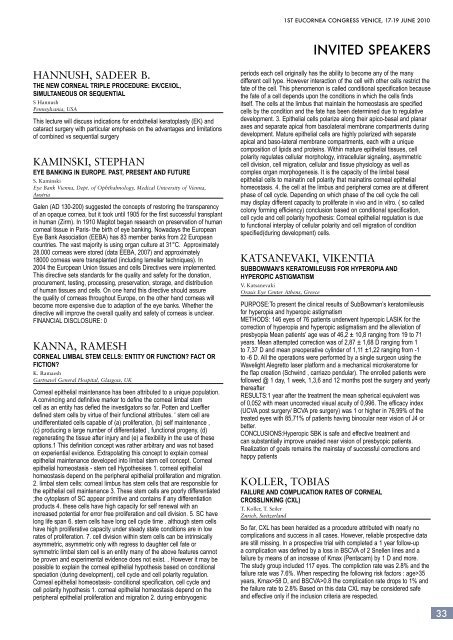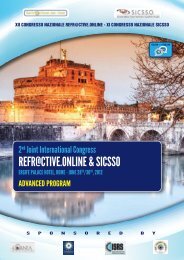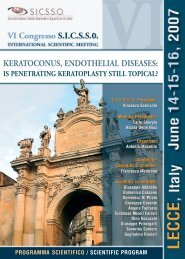1st EuCornea Congress
1st EuCornea Congress
1st EuCornea Congress
You also want an ePaper? Increase the reach of your titles
YUMPU automatically turns print PDFs into web optimized ePapers that Google loves.
<strong>1st</strong> <strong>EuCornea</strong> <strong>Congress</strong> venice, 17-19 june 2010<br />
INVITED SPEAKERS<br />
Hannush, Sadeer B.<br />
The new corneal triple procedure: EK/CE/IOL,<br />
simultaneous or sequential<br />
S Hannush<br />
Pennsylvania, USA<br />
This lecture will discuss indications for endothelial keratoplasty (EK) and<br />
cataract surgery with particular emphasis on the advantages and limitations<br />
of combined vs sequential surgery<br />
Kaminski, Stephan<br />
Eye banking in Europe. Past, present and future<br />
S. Kaminski<br />
Eye Bank Vienna, Dept. of Ophthalmology, Medical University of Vienna,<br />
Austria<br />
Galen (AD 130-200) suggested the concepts of restoring the transparency<br />
of an opaque cornea, but it took until 1905 for the first successful transplant<br />
in human (Zirm). In 1910 Magitot began research on preservation of human<br />
corneal tissue in Paris- the birth of eye banking. Nowadays the European<br />
Eye Bank Association (EEBA) has 83 member banks from 22 European<br />
countries. The vast majority is using organ culture at 31°C. Approximately<br />
28.000 corneas were stored (data EEBA, 2007) and approximately<br />
18000 corneas were transplanted (including lamellar techniques). In<br />
2004 the European Union tissues and cells Directives were implemented.<br />
This directive sets standards for the quality and safety for the donation,<br />
procurement, testing, processing, preservation, storage, and distribution<br />
of human tissues and cells. On one hand this directive should assure<br />
the quality of corneas throughout Europe, on the other hand corneas will<br />
become more expensive due to adaption of the eye banks. Whether the<br />
directive will improve the overall quality and safety of corneas is unclear.<br />
FINANCIAL DISCLOSURE: 0<br />
Kanna, Ramesh<br />
Corneal limbal stem cells: entity or function Fact or<br />
fiction<br />
K. Ramaesh<br />
Gartnavel General Hospital, Glasgow, UK<br />
Corneal epithelial maintenance has been attributed to a unique population.<br />
A convincing and definitive marker to define the corneal limbal stem<br />
cell as an entity has defied the investigators so far. Potten and Loeffler<br />
defined stem cells by virtue of their functional attributes. ‘ stem cell are<br />
undifferentiated cells capable of (a) proliferation, (b) self maintenance ,<br />
(c) producing a large number of differentiated , functional progeny, (d)<br />
regenerating the tissue after injury and (e) a flexibility in the use of these<br />
options.1 This definition concept was rather arbitrary and was not based<br />
on experiential evidence. Extrapolating this concept to explain corneal<br />
epithelial maintenance developed into limbal stem cell concept. Corneal<br />
epithelial homeostasis - stem cell Hypothesises 1. corneal epithelial<br />
homeostasis depend on the peripheral epithelial proliferation and migration.<br />
2. limbal stem cells: corneal limbus has stem cells that are responsible for<br />
the epithelial cell maintenance 3. These stem cells are poorly differentiated<br />
;the cytoplasm of SC appear primitive and contains if any differentiation<br />
products 4. these cells have high capacity for self renewal with an<br />
increased potential for error free proliferation and cell division. 5. SC have<br />
long life span 6. stem cells have long cell cycle time . although stem cells<br />
have high proliferative capacity under steady state conditions are in low<br />
rates of proliferation. 7. cell division within stem cells can be intrinsically<br />
asymmetric, asymmetric only with regress to daughter cell fate or<br />
symmetric limbal stem cell is an entity many of the above features cannot<br />
be proven and experimental evidence does not exist. . However it may be<br />
possible to explain the corneal epithelial hypothesis based on conditional<br />
speciation (during development), cell cycle and cell polarity regulation.<br />
Corneal epithelial homeostasis- conditional specification, cell cycle and<br />
cell polarity hypothesis 1. corneal epithelial homeostasis depend on the<br />
peripheral epithelial proliferation and migration 2. during embryogenic<br />
periods each cell originally has the ability to become any of the many<br />
different cell type. However interaction of the cell with other cells restrict the<br />
fate of the cell. This phenomenon is called conditional specification because<br />
the fate of a cell depends upon the conditions in which the cells finds<br />
itself. The cells at the limbus that maintain the homeostasis are specified<br />
cells by the condition and the fate has been determined due to regulative<br />
development. 3. Epithelial cells polarize along their apico-basal and planar<br />
axes and separate apical from basolateral membrane compartments during<br />
development. Mature epithelial cells are highly polarized with separate<br />
apical and baso-lateral membrane compartments, each with a unique<br />
composition of lipids and proteins. Within mature epithelial tissues, cell<br />
polarity regulates cellular morphology, intracellular signaling, asymmetric<br />
cell division, cell migration, cellular and tissue physiology as well as<br />
complex organ morphogenesis. It is the capacity of the limbal basal<br />
epithelial cells to mainatin cell polarity that mainatins corneal epithelial<br />
homeostasis. 4. the cell at the limbus and peripheral cornea are at different<br />
phase of cell cycle. Depending on which phase of the cell cycle the cell<br />
may display different capacity to proliferate in vivo and in vitro. ( so called<br />
colony forming efficiency) conclusion based on conditional specification,<br />
cell cycle and cell polarity hypothesis: Corneal epithelial regulation is due<br />
to functional interplay of cellular polarity and cell migration of condition<br />
specified(during development) cells.<br />
Katsanevaki, Vikentia<br />
SubBowman’s keratomileusis for hyperopia and<br />
hyperopic astigmatism<br />
V. Katsanevaki<br />
Orasis Eye Center Athens, Greece<br />
Purpose:To present the clinical results of SubBowman’s keratomileusis<br />
for hyperopia and hyperopic astigmatism<br />
Methods: 146 eyes of 76 patients underwent hyperopic LASIK for the<br />
correction of hyperopia and hyperopic astigmatism and the alleviation of<br />
presbyopia Mean patients’ age was of 46,2 ± 10,8 ranging from 19 to 71<br />
years. Mean attempted correction was of 2,87 ± 1,68 D ranging from 1<br />
to 7,37 D and mean preoperative cylinder of 1,11 ±1,22 ranging from -1<br />
to -6 D. All the operations were performed by a single surgeon using the<br />
Wavelight Alegretto laser platform and a mechanical microkeratome for<br />
the flap creation (Schwind , carriazo pendular). The enrolled patients were<br />
followed @ 1 day, 1 week, 1,3,6 and 12 months post the surgery and yearly<br />
thereafter<br />
Results:1 year after the treatment the mean spherical equivalent was<br />
of 0,052 with mean uncorrected visual acuity of 0,996. The efficacy index<br />
(UCVA post surgery/ BCVA pre surgery) was 1 or higher in 76,99% of the<br />
treated eyes with 85,71% of patients having binocular near vision of J4 or<br />
better.<br />
Conclusions:Hyperopic SBK is safe and effective treatment and<br />
can substantially improve unaided near vision of presbyopic patients.<br />
Realization of goals remains the mainstay of successful corrections and<br />
happy patients<br />
Koller, Tobias<br />
Failure and complication rates of corneal<br />
crosslinking (CXL)<br />
T. Koller, T. Seiler<br />
Zurich, Switzerland<br />
So far, CXL has been heralded as a procedure attributed with nearly no<br />
complications and success in all cases. However, reliable prospective data<br />
are still missing. In a prospective trial with completed a 1 year follow-up<br />
a complication was defined by a loss in BSCVA of 2 Snellen lines and a<br />
failure by means of an increase of Kmax (Pentacam) by 1 D and more.<br />
The study group included 117 eyes. The compliction rate was 2.8% and the<br />
failure rate was 7.6%. When respecting the following risk factors : age>35<br />
years, Kmax>58 D, and BSCVA>0.8 the complication rate drops to 1% and<br />
the failure rate to 2.8% Based on this data CXL may be considered safe<br />
and effective only if the inclusion criteria are respected.<br />
33







